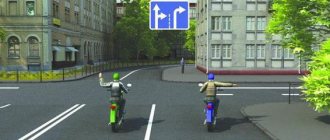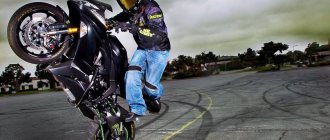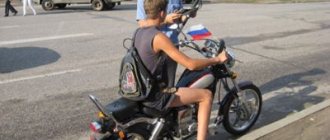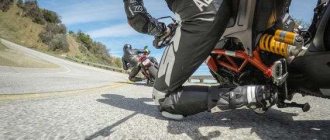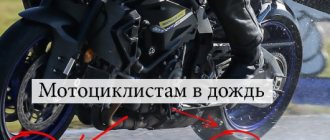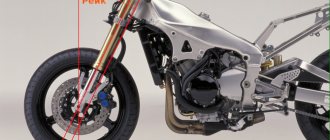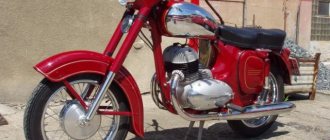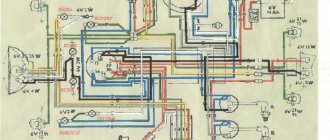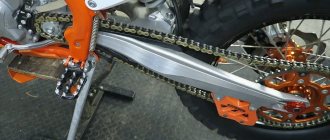When taking difficult turns, you need to know how the bike will behave in a given situation. While driving on a straight road is not particularly difficult, turning at high speed can cause injury for inexperienced drivers. To navigate a winding road at a good pace, you need to be able to play with the fuel supply. If you do not increase speed in a timely manner, you may be carried off the track. To overcome the centrifugal force, the gas is squeezed to full speed before turning. After which the idle speed drops, and the bike leans towards the bend in the road. Let's take a closer look at how to corner a motorcycle.
In many ways, the features of passing the route depend on the class of the bike . Thus, on sports units the tilt is carried out to a greater extent than on other motorcycles. On choppers, turns are made mainly by steering. Adding throttle relieves the bike of the load on the fork. This improves the suspension's ability to respond better to uneven road surfaces and eliminates unnecessary stress on the structure. You need to add and release the gas smoothly, without aggressive jerks, having calculated the optimal option for the entire distance of the route.
Among motorcyclists, questions are now popular about how to take turns on a motorcycle with the rear part of the unit skidding. To perform this trick, you must use the clutch correctly. Having brought the revolutions to 6-7 thousand, depress the clutch and, releasing the gas, wait until the wheels begin to rotate at different speeds. At this moment, you will feel the back part smoothly move to the side. Then begin to tilt your body in the direction of the skid. If movement becomes difficult, use the front brakes to reduce traction. This is a very unsafe way to drive, so wear protective gear and try not to drift in crowded places.
Planning
You are planning to enter a turn. And planning should begin with determining the entry point, this is a key element in turns. On an open road or highway, select a corner entry point. It takes time and understanding to appreciate the benefits of designating such a place. Choosing such a point before each turn is much better than waiting for a turn to force it due to high speed or poor visibility. When you plan, you control the machine.
Gyroscopic effect and speed
Has it ever occurred to you why a moving motorcycle is stable, but a motorcycle standing still falls? The stability of the motorcycle is given by the gyroscopic effect created by the wheels rotating around their axis. The wheels are a powerful gyroscope, similar to a children's spinning top. Remember how, as the rotation stops, the spinning top increases its “sway” and gradually loses stability. And as soon as the spinning top stops rotating, it immediately loses its balance and falls.
A motorcycle behaves in much the same way. The gyroscopic effect resulting from the high speed of rotation of the wheel stabilizes the position of the bike. That is, high speed makes the bike stable in turns. Therefore, the higher the speed, the sharper the turn you can actually make. It should be borne in mind that at the same time as the stability of the motorcycle increases, its maneuverability decreases and it becomes more difficult for it to steer.
Tool for the motorcyclist
Turning point is when you stop braking/slow down, lean the bike (make a counter turn) and begin to accelerate smoothly. This is where you start to turn, going in a different direction. It is also a guideline for your other actions. Choosing a turning point helps keep things organized and flowing. “The entry point is a tool and like any other tool, you have to learn how to use it.” Every time you approach a turn, make sure you plan where to start the turn.
Where is the corner entry point? The answer to this question is a mystery to some people and sheds light on modern thinking about motorcycle riding. The corner entry point starts where you need to start the turn - where the straight ends and the curve begins.
Common mistakes
The confusion of drivers in an extreme situation forces them to resort to sharply pressing the brakes, forgetting how to turn correctly on a motorcycle. This is the worst way to get out of this situation. Braking causes the rear wheel to unload and lose traction. Typically, a sudden decrease in speed leads to departure from the road lane. On slippery surfaces, you will simply turn the bike on its side and have an accident.
With loose and dry surfaces, sharp braking creates increased load on the suspension. When hitting a bump, the driver is thrown out of the saddle, because the shock absorbers are unable to cope with the shock received and simply transfer all its force to the biker. What to do if you find yourself in such a situation? There are three most correct ways to get out of the situation:
- Fixing the gas lever. By clamping the fuel supply, you will not allow the engine to gain high speed due to the high speed of rotation of the wheels. This will reduce the jerk force when restoring traction. However, this method is very difficult to implement. The instinct of self-preservation will force you to hit the brakes.
- Very slow gas release. This action will allow you to control the wheels through the engine. An ineffective technique, however, it is much better than abruptly cutting off the fuel supply.
- If you have enough strength to lift the bike while leaning, then adding throttle is ideal. Increasing the lean angle will increase traction and stabilize the bike. Lifting must be done smoothly without jerking.
- Tilt helps shift the center of gravity. This increases the bike's stability.
- Hanging allows you to take a turn with a smaller tilt of the bike, which gives greater adhesion of the rubber to the road surface, due to the increase in area. This will allow you to better control the trajectory of movement.
Why tilt your body if it can lead to a dangerous situation? Everything is very simple and based on the laws of physics. There are two reasons for hanging your torso off the bike:
Ideal track?
In books on driving techniques, we find the optimal places to enter a turn, but their authors recommend looking for an individual point at which we will feel confident. There is no single ideal entry point, and neither is the route. This is a place that you assign to yourself - after a few turns, you will know which point is the most optimal for you. The more turns you make to establish entry points, the more points you'll score on less familiar turns.
On the other hand, it's not the case that if you don't set an entry point, it doesn't exist. You always make a turn by starting the maneuver at some point. How conscious this is is another matter. Consciously deciding where to start a turn helps you organize all the elements and, as a result, enjoy a smooth and confident turn.
Countersteering
Countersteering is the only correct way to control a bike in a curved motion. It uses the force resulting from centripetal and gravity, and the gyroscopic effect created by the wheels.
The essence of counter-steering: when making a turn, we push away from ourselves the steering wheel towards which we are turning. And vice versa: by pulling the steering wheel towards us in the direction of the turn, we will change the direction of the turn.
The principle of counter-steering is used to maintain balance at low speeds, when the gyroscopic effect does not provide sufficient stabilization. In these cases, we instinctively turn the steering wheel in the direction of a likely fall. As a result, the two-wheeled friend deviates in the opposite direction, and balance is maintained.
Awareness is important
When watching the races, you can see how accurately the racers stick to their corner entry points. It's worth starting to practice, consciously choosing the entry point into the turn. Determine where you should start turning. Find a landmark: a scratch on the asphalt, a stone, a tree, a road pole - something that is easy to notice when turning. Start your workout at a slower speed. If you don't know where to corner and lean the bike, going faster won't make it any easier. “Too often, motorcyclists try to correct fundamental mistakes by accelerating and hoping to gain speed through a corner.”
It's all about not panicking. If we don't consciously choose where to go, defensiveness and panic will do it for us. “Without a turning point, you'll ruin the whole turn. A mistake at the start of the turn will cause you to deviate from your chosen line and miss important points later.” You can see how important it is to consciously identify your turn entry point on a decreasing radius turn. You'd better delay your move and find the perfect spot. Even a wrong turn is better than nothing.
Gas operation
A motorcycle in motion has different areas of contact between the wheels and the road surface. At the rear it is greater than at the front, because it is the leader and experiences a heavy load. Accordingly, the rear wheel has better grip. But when cornering, for various reasons, the weight distribution between the wheels changes.
This is fraught with loss of control:
- Sharp throttle will cause skidding and overturning.
- Braking will cause overload on the front wheel. There will be a force that pulls the motorcycle out of the turn. A decrease in gyroscopic moment will lead to loss of stability and a fall.
- By squeezing the clutch, you can go through the turn, but you shouldn’t do this.
The correct tactic would be arcing movement with acceleration. That is, having entered the trajectory, you need to periodically smoothly open the gas in order to moderately load the rear wheel. So, by slightly increasing the speed, we will avoid skidding and turn quickly and safely.
Efficient and safe cornering
How to determine the entry point into a turn? We advise you not to focus on the inside of the turn - this can lead to us entering the turn too early and ending up on the outside edge at the exit. There is a possibility that we may go off the road. You will have to drive longer in the assembly to complete the maneuver. We also need to be patient before a corner - uncertainty about speed, what's around the corner and how it will go overall can lead to premature failure of the bike. Patience will pay off - you'll see what's around the corner faster and get out of it faster.
Although the build ride is often the most exciting experience for a motorcyclist, it should be kept as short as possible. Entering a corner too early will cause you to ride lean for longer and may limit your visibility of what's around the corner. Entering a corner too late may, in turn, require you to lean more into your approach, make an adjustment, hit the throttle, or turn again. Unfortunately, only minor adjustments are possible when cornering, and each of them carries additional risk.
As you can see, we always need to choose a corner entry point - regardless of whether we are driving along the highway or not. Going from one place to another is not the same as a highway where the turns are predictable, clean and empty. When driving on the street or outside the city, you should consciously choose an entry point for a turn that is adapted to the road conditions, weather and speed.
Post Views: 913
Trajectory
Traditionally, the trajectory of a racing turn is assumed to be the most straightened with the largest possible radius. This allows you to maintain an adequate and safe inclination to the road.
This trajectory consists of the following stages:
- following the outside of the track;
- a sharp entry into the turning arc in the direction of the apex on the inside of the track;
- from the apex there is a smooth exit from the arc again to the outside of the track.
